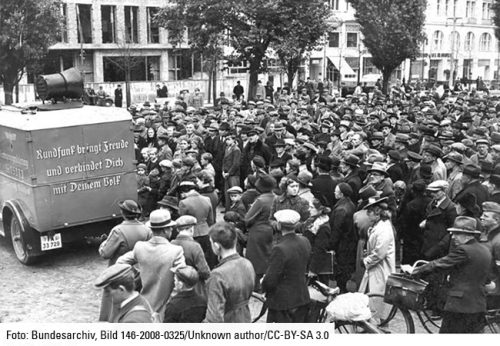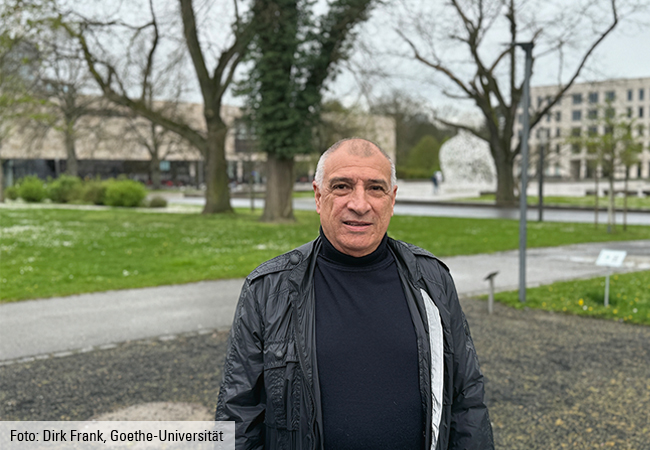German Research Foundation-funded project “Collection of Adolf Hitler’s Speeches, 1933-1945”, headed by Professor Christopher Cornelißen, to publish new edition of Hitler’s post-1933 speeches
His piercing voice is unmistakable, it is familiar from dozens of recordings. Despite that, to date very few of Adolf Hitler’s speeches have been generally accessible. That is about to change: Scientists plan to comprehensively edit and publish them. The research project “Collection of Adolf Hitler’s Speeches, 1933-1945”, funded by the German Research Foundation (DFG), was officially launched on January 1, 2024. Christoph Cornelißen, Professor of Contemporary History (European History) at Goethe University Frankfurt, was one of its initiators. He and his team will play a key role in the project.

Given that the National Socialist era has been at the focus of contemporary historical research since 1945, it might seem astonishing to laypeople that Adolf Hitler’s speeches, from the “seizure of power” onwards, do not exist in a pristinely edited scientific form. Written versions of his speeches of course exist – contained in the four-volume edition compiled by Würzburg-based archivist Max Domarus. “This work has served as the main reference point since it was first published, and it has shaped research to this day,” explains Cornelißen. It turns out, however, that the edition was not only incomplete, Domarus also partially abridged and modified individual speeches, which were almost all based on the sometimes heavily redacted versions published in the “Völkischer Beobachter”, the newspaper of the National Socialist German Workers’ Party (NSDAP). What motivated the historian, teacher, writer and publicist, who already began collecting Adolf Hitler’s utterances in 1932, has since become the subject of its own research.
Professor Christoph Cornelißen and his team – Dr. Dirk Stolper, Dr. Muriel Favre and Nikolaus Freimuth M.A. – have set themselves the goal of making the speeches broadcast on the radio available to researchers and the public in a better quality – not least since technological developments open up completely new possibilities. Together with the Leibniz Institute for Contemporary History in Munich and Berlin, the University of Marburg, the German Broadcasting Archive (DRA) in Frankfurt and Potsdam-Babelsberg, as well as the Mannheim-based Leibniz Institute for the German Language (IDS), they successfully applied to the German Research Foundation (DFG) for funding for the collaborative project “Collection of Adolf Hitler’s Speeches, 1933-1945”. Designed to take seven years, and with an overall budget of €4 million, the project aims to make all important texts and audio transmissions available in a scientifically reliable form. While seven years may sound like a long time at first, given the material to be examined, this timeframe is relatively short.
300 speeches preserved as audio files

There is, after all, a vast amount of material: Almost 800 of Adolf Hitler’s speeches have survived, most of them in printed form from the “Völkischer Beobachter” newspaper. Around 300 speeches have been preserved as audio files. The broadcasting companies stored the recordings on different types of media until 1945, after which the British took many of them to London as spoils of war. Copies then returned to Germany along various routes. Starting in 1952, the German Broadcasting Archive began collecting all sound recordings from the Nazi era that have come to light. While the official sources have long since dried up, to this day, there are cases where a recording of a Hitler speech from a private source occasionally surfaces. At the beginning of the new millennium, the German Broadcasting Archive began digitizing this collection – albeit for broadcasting purposes only. “It’s a real treasure trove, but it doesn’t meet scientific standards,” explains Dr. Favre. The German Broadcasting Archive is nevertheless a very important partner: “They are the experts when it comes to the history of how the recordings were created and transmitted,” says Favre.
Processing with modern media
The project sets out to create an edition that meets scientific requirements and at the same time opens up entirely new research perspectives. The team at Goethe University Frankfurt will now systematically examine the recordings held in the German Broadcasting Archive and compare them with other versions of the respective speeches. The aim is to reconstruct recordings that are as true to reality as possible. To enable searches for specific words or audience reactions in the audio files, computer scientist Professor Bernd Freisleben from the University of Marburg will contribute his expertise and prepare the files identified by the Frankfurt team using artificial intelligence and audio recognition. “This is a quantum leap for historians,” Favre says, adding that this will make it possible to search directly in the audio file without taking a detour via the transcription.
The Leibniz Institute for Contemporary History will identify and annotate the texts of the speeches based on the audio recordings as well as other sources, and publish them as printed volumes. An online Open Access version will follow. The texts of the speeches and the commentaries will also be included in the audio edition. Where possible, this will also include scientifically relevant information on how the speeches were orchestrated on stage or on the radio. Were there interjections? Did the speaker himself make cross-references to other speeches? The announcement of the speech in the press and on the radio, the composition of the audience and what people wore on stage also play a role. “It is interesting that Goebbels, for example, was always dressed in civilian clothes, but Hitler always appeared in uniform,” says Dr. Dirk Stolper.
“We want to put research into the history of how Hitler’s speeches were received on a new footing,” says Cornelißen. The perception of Hitler in historical research has changed several times over the decades since 1945, he points out. While the notion of the all-powerful Führer, who had the Germans firmly under his control (thereby seemingly lessening their own responsibility), was widespread in the 1950s, Hans Mommsen saw in him a “weak dictator” who was “frequently uncertain, and exclusively concerned with upholding his prestige and personal authority”. According to Mommsen, the extermination of the European Jews took place in a process of “cumulative radicalization”, which did not even necessitate an explicit order from Hitler. Others, including Daniel Goldhagen (“Hitler’s Willing Executioners”), also picked up this line of thought in their work. “The question remains the same until this day: Who were the perpetrators?” says Cornelißen, adding that the speeches can be used to uncover the “ideological core” of Hitler’s political being. The audio files in turn can help corroborate that this core existed and that Hitler held onto it. While this won’t put an end to the dispute among historians, Cornelißen says the discussion could then be conducted closer to the original sources.
Analysis of the rhetorical techniques
What remains undisputed is that Hitler had extraordinary oratorical and theatrical talent. After having attended a course in public speaking at Munich University in 1919, from then on he spoke in front of ever larger crowds. Just how strong of an effect he had on his listeners is shown, for example, by the fact that even educated businesspeople and military personnel succumbed to his arguments against their better judgment. The linguistic techniques he used in this context will also be part of the project: The Leibniz Institute for the German Language oversees a sub-project that focuses on tools for linguistic and rhetorical analysis.
“We like to believe that no one would be taken in by such an orator nowadays. But we shouldn’t be so sure,” says Cornelißen in drawing a link from the past to the present. The project is about far more than just reconstructing Hitler as a historical phenomenon, he adds: It can also be used to examine how political rhetoric in general becomes a powerful tool in times of crisis.












